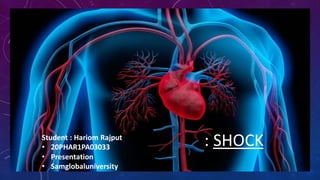SHOCK II Slide II Hariom Rajput II Bhopal
•
0 likes•2 views
Shock
Report
Share
Report
Share
Download to read offline

Recommended
Recommended
More Related Content
Similar to SHOCK II Slide II Hariom Rajput II Bhopal
Similar to SHOCK II Slide II Hariom Rajput II Bhopal (20)
Systemic Lupus Erythematosus by Dr. Daniel B. Yidana

Systemic Lupus Erythematosus by Dr. Daniel B. Yidana
agranulocytosis also known as agranulosis or granulopenia

agranulocytosis also known as agranulosis or granulopenia
Calcium imbalances- hypocalcemia and hypercalcemia 

Calcium imbalances- hypocalcemia and hypercalcemia
Recently uploaded
Recently uploaded (20)
Denture base resins materials and its mechanism of action

Denture base resins materials and its mechanism of action
CONGENITAL HYPERTROPHIC PYLORIC STENOSIS by Dr M.KARTHIK EMMANUEL

CONGENITAL HYPERTROPHIC PYLORIC STENOSIS by Dr M.KARTHIK EMMANUEL
5CL-ADB powder supplier 5cl adb 5cladba 5cl raw materials vendor on sale now

5CL-ADB powder supplier 5cl adb 5cladba 5cl raw materials vendor on sale now
Failure to thrive in neonates and infants + pediatric case.pptx

Failure to thrive in neonates and infants + pediatric case.pptx
Circulation through Special Regions -characteristics and regulation

Circulation through Special Regions -characteristics and regulation
TEST BANK for The Nursing Assistant Acute, Subacute, and Long-Term Care, 6th ...

TEST BANK for The Nursing Assistant Acute, Subacute, and Long-Term Care, 6th ...
Muscle Energy Technique (MET) with variant and techniques.

Muscle Energy Technique (MET) with variant and techniques.
Renal Replacement Therapy in Acute Kidney Injury -time modality -Dr Ayman Se...

Renal Replacement Therapy in Acute Kidney Injury -time modality -Dr Ayman Se...
Cardiac Impulse: Rhythmical Excitation and Conduction in the Heart

Cardiac Impulse: Rhythmical Excitation and Conduction in the Heart
TEST BANK For Timby's Introductory Medical-Surgical Nursing, 13th Edition by ...

TEST BANK For Timby's Introductory Medical-Surgical Nursing, 13th Edition by ...
SHOCK II Slide II Hariom Rajput II Bhopal
- 1. SHOCK : SHOCK Student : Hariom Rajput • 20PHAR1PA03033 • Presentation • Samglobaluniversity
- 2. {CONTENTS} 1. INTRODUCTION 2. DEFINITION 3. INCIDENCE 4. TYPES 5. ETIOLOGY 6. RISK FACTORS 7. PATHOPHYSIOLOGY 8. CLINICAL MANIFESTATIONS 9. DIAGNOSIS EVALUATION 10. COMPLICATIONS 11. MEDICAL MANAGEMENT 12. NURSING MANAGEMENT 13. HEALTH EDUCATION
- 3. INTRODUCTION • Shock may be defined as inadequate delivery of oxygen and nutrients to maintain normal tissues & cellular function.
- 4. DEFINITION • Shock is a life-threatening situation due to poor tissue Perfusion with imapaired cellular metabolism mani- festated entered by serious pathophysiological abnormalities.
- 5. INCIDENCE • Cardiogenic shock occurs in 8.6% of patient with ST segment elevation • Myocardial ischemia with 29% of those presenting to the hospital already in shock. • 2% of non ST segment elevation MI.
- 6. TYPES 1.CARDIOGENIC SHOCK: Cardiogenic shock is characterised by reduced pumping ability of heart due to intrinsic myocardial damage, obstruction to flow. Hypertrophy.. cardio myopathy, pulmonary edema. Hypertension, weak pulse, oligo, urea and pulmonary embolism .
- 7. 2.HYPOROLEMIC SHOCK An emergency condition in which severe blood and fluid loss make the heart unable to pump blood to the body.
- 8. 3.SEPTIC SHOCK : It is a serious medical condition that can occur when an infection in your body causes extremely low blood pressure and organ failure due to sepsis.
- 9. OTHER TYPES 1.NEUROGENIC SHOCK : Neurogenic shock occurs in the setting of anaesthetic accident or spinal cord injury of vascular tone and peripheral pulling of blood. causes loss
- 10. 2.TRAUMATIC SHOCK : It is caused by a life- threatening reaction of the body to a substance to which a patient is extremely allergic.
- 11. ETIOLOGY *Severe allergic reaction *Significant blood loss *Heart Failure *Blood infections * Dehydration * Poisoning * Burns
- 12. RISK FACTORS *Coronary artery disease *High blood pressure * High cholesterol * Diabetes * Use of Tobacco products * Overweight and obesity
- 14. CLINICAL MANIFESTATIONS 1.EXEMELYLOW BLOOD PRESSURE 2.WEAKNESS 3.CHEST PAIN 4.WEAK PULSE 5.PROFUSE SWEATING 6.DIZZINESS 7.BLINKING EYES 8. UNCONSCIOUSNESS 9.HEADACHE 10. FEELING ANXIOUS OR CONFUSED 11. RAPID SHALLOW BREATHING 12. CYANOSIS
- 15. DIAGNOSTIC EVALUATION • HOSTORY COLLECTION • PHYSICAL EXAMINATION • BLOOD CULTURE & SENSITIVITY TEST • CBC • X-RAY , CT-SCAN • ECHOCARDIOGRAM
- 16. COMPLICATIONS 1. LOSS OF CONSCIOUSNESS 2. RESPIRATORY FAILURE 3. COAGULATION DISORDER 4. MULTI ORGAN DAMAGE 5. COMA 6. DEATH
- 17. MANAGEMENT MEDICAL MANAGEMENT • CRYSTALLLATORS:RINGER’SSOLUTION AND NORNAL SALINE • INOTROPICAGENTS : DOPAMINE,DOBUTAMINE& EPINEPHRINE • RESODILATOR:NITROGLYCERIN • DIURATICS:LASILACTONE, FUROSEMIDE • ANTIBIOTICS: CIPROFLOXACIN, AMOXICILLINE &CLAVULANIC ACID • ANTIHISTAMINES:EPINEPHRINE • CORTICOSTEROIDS:DEXAMETHASONE • SODIUM BICARBONATE:USED TO TREAT METABOLICACIDOSIS • BRONCHODIALOTERS:ATROPINE, AMINOPHYLLINE ETC.
- 18. NON-PHARMACHOLOGICAL 1. MODIFIERAL TRENDLENBERG POSITION 2. ASSESSMENT OF VITAL SIGNS 3. OXYGEN ADMINISTRATION 4. PARENTERAL NUTRITION SUPPORT
- 19. NURSING MANAGEMENT 1. Continuous monitoring. 2. Assess airway, breathing and circulationof the patient. 3. Check for urine output of the client. 4. Suggestto eat small frequentmeal, eat more salt and drink more fluids 5. Increase amount of potassium in your diet. 6. Avoid coffee and alcohol
- 20. NURSING DIAGNOSIS 1. Impaired tissue perfusion related to decrease output. 2. Ineffective breathing pattern related to hypoxia 3. Fluid volume deficit related to vomiting haemorrhage. 4. Acute pain related to myocardial infarction. 5. Imbalanced nutrition less than body requirement related to inadequate intake of food.
- 21. HEALTH EDUCATION 1. ADOPT HEART HEALTHY LIFESTYLE 2. TAKE HEALTHY DIET : LOW IN SODIUM AND FAT 3. CONTROL HYPERTENSION AND DIABETES 4. REDUCE OBESITY , BE PHYSICALLY ACTIVE 5. QUIT SMOKING THANK YOU